Discover 35 hidden attractions, cool sights, and unusual things to do in Waltham (United States). Don't miss out on these must-see attractions: Rose Art Museum, Charles River Museum of Industry & Innovation, and Christ Episcopal Church. Also, be sure to include Stonehurst in your itinerary.
Below, you can find the list of the most amazing places you should visit in Waltham (Massachusetts).
Table of Contents
Rose Art Museum
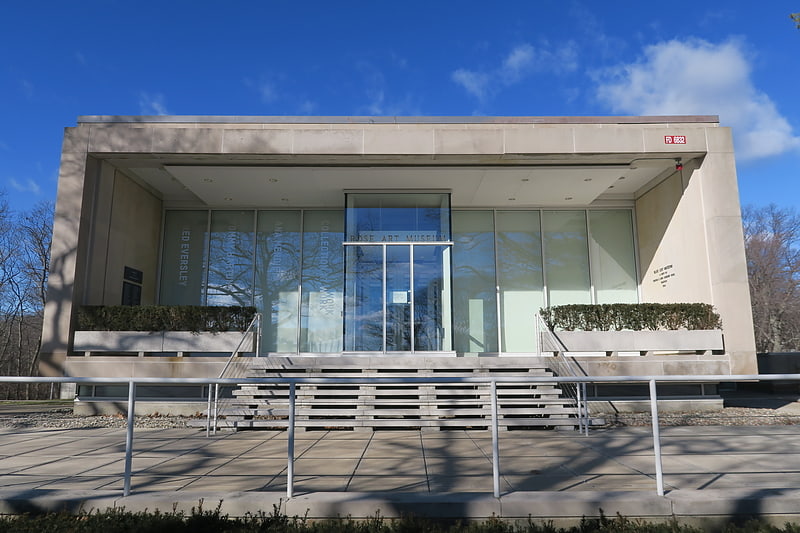
Museum in Waltham, Massachusetts. The Rose Art Museum, founded in 1961, is a part of Brandeis University in Waltham, Massachusetts, US. Named after benefactors Edward and Bertha Rose, it offers temporary exhibitions, and it displays and houses works of art from the permanent collection of 9,000 objects. The museum has one of the largest collections of modern and contemporary art in New England. Since its inauguration, the Rose Art Museum has been recognized for its avant-garde and forward-thinking approach to modern and contemporary art. In 1970, the museum presented to the public Vision & Television, the first video art exhibition in the United States.[1]
Address: 415 South St, 02453 Waltham (Waltham)
Charles River Museum of Industry & Innovation
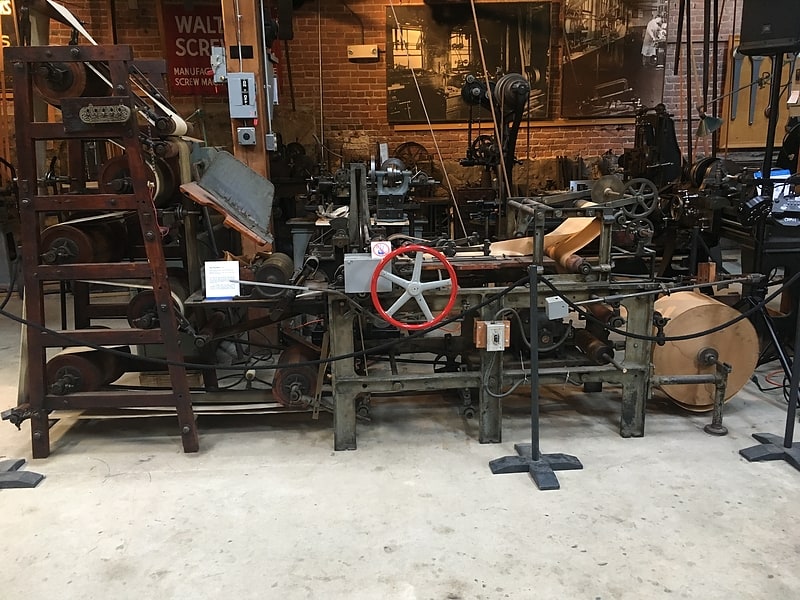
Charles River Museum of Industry & Innovation is a museum of the American Industrial Revolution located on the Charles River Bike Path, near the intersection of the Charles River and Moody Street in Waltham, Massachusetts. It houses and displays machinery and artifacts of the industrial revolution from the nineteenth and twentieth centuries. The building was originally built as part of the Boston Manufacturing Company, Francis Cabot Lowell's seminal, fully integrated textile mill. The museum, which was incorporated in 1980 and opened to the public in 1988, takes up only a small portion of the previous mill building complex.[2]
Address: 154 Moody St, 02453 Waltham (Waltham)
Christ Episcopal Church
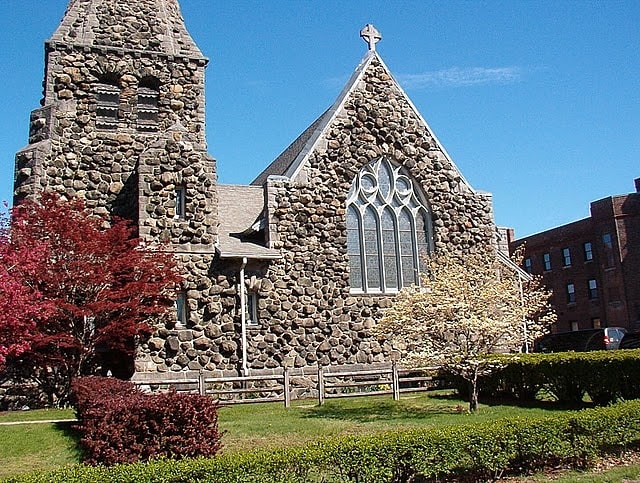
Episcopal church in Waltham, Massachusetts. Christ Church is a historic Episcopal church at 750 Main Street in Waltham, Massachusetts. The church is a parish of the Episcopal Diocese of Massachusetts, and was named to the National Register of Historic Places in 1989.
The church was founded in 1848, but a local hall was used for services until a wooden church was built in 1849. The wooden structure eventually proved inadequate and a larger church designed by Peabody and Stearns was built of local fieldstone at the current location between 1897 and 1898.
The church contains stained glass windows produced by several noteworthy manufacturers, including Clayton and Bell, Charles Connick, Louis Comfort Tiffany, and Donald MacDonald. Eight rectors have served the church since its founding.[3]
Address: 750 Main St # 1, 02451 Waltham (Waltham)
Stonehurst
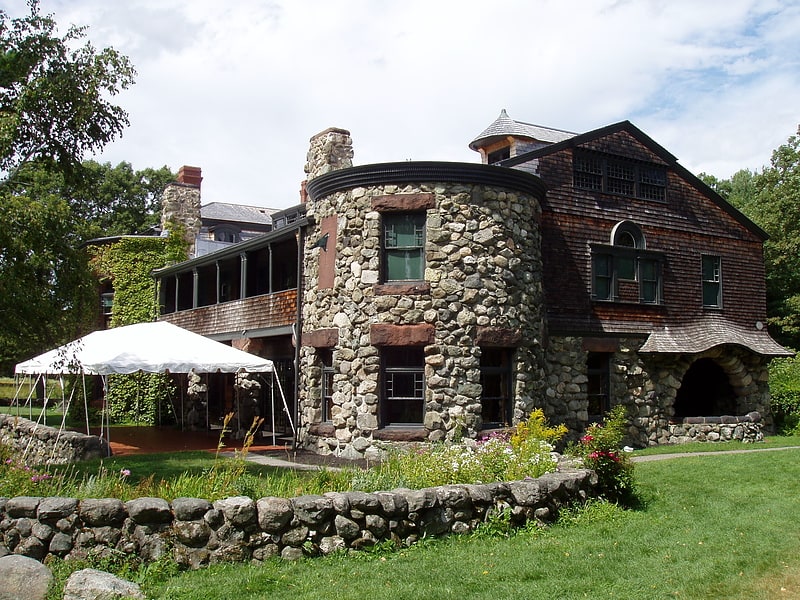
Historical landmark in Waltham, Massachusetts. The Robert Treat Paine Estate, known as Stonehurst, is a country house set on 109 acres in Waltham, Massachusetts. It was designed for philanthropist Robert Treat Paine in a collaboration between architect Henry Hobson Richardson and landscape architect Frederick Law Olmsted. It is located at 100 Robert Treat Paine Drive. Since 1974 the estate has been owned by the City of Waltham and its grounds kept as a public park, and is believed to be the only residential collaboration by Richardson and Olmsted that is open to the public.[4]
Address: 100 Robert Treat Paine Dr, 02452 Waltham (Waltham)
St. Charles Borromeo Church

Church building in Waltham, Massachusetts. The St. Charles Borromeo Church is a historic Catholic church building in Waltham, Massachusetts. Built in 1922, it is a high quality example of Italian Renaissance Revival architecture, and is emblematic of the shift on Waltham's south side from a predominantly Protestant population to one of greater diversity. The building was listed on the National Register of Historic Places in 1989.[5]
Address: 30 Taylor St, 02453-5299 Waltham (Waltham)
Prospect Hill
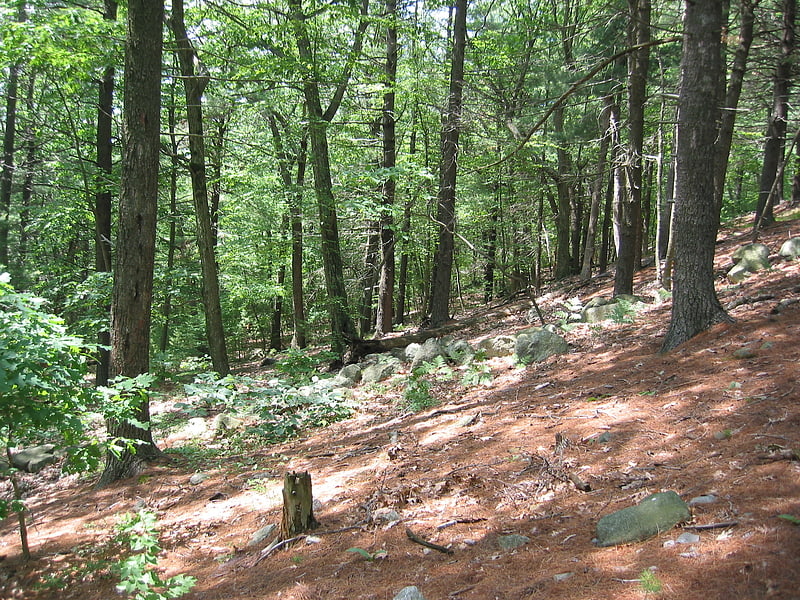
Prospect Hill is a hill in Waltham, Massachusetts, United States, and is the third-highest point within 12 miles of downtown Boston. The hill is in Prospect Hill Park on the west side of Waltham, near Route 128. It is exceeded in height by Great Blue Hill and Chickatawbut Hill, both in the Blue Hills Reservation. It is not to be confused with the much lower, historically significant Prospect Hill near Union Square in Somerville.
There are two different summits; Big Prospect, at 485 feet (148 m), and Little Prospect at 435 feet (133 m). Both summits provide some of the best views of the Boston basin. In clear weather, Monadnock, 54 miles away, is visible in an approximately northwest direction. The hill and the surrounding area make up the 273-acre (110 ha) Prospect Hill Park, a municipal park with numerous hiking trails and picnic areas that is the oldest and largest public open space in Waltham.[6]
Mount Feake Cemetery
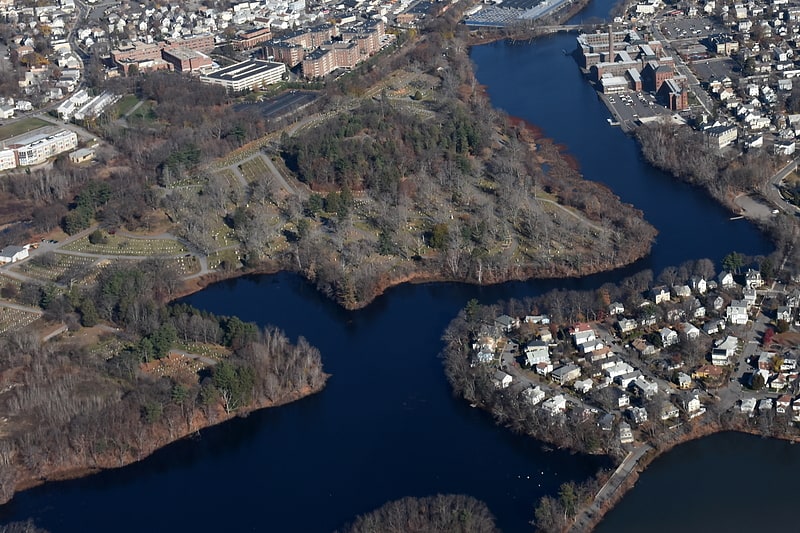
Cemetery in Waltham, Massachusetts. Mount Feake Cemetery is a historic cemetery at 203 Prospect Street in Waltham, Massachusetts.[7]
Address: 203 Prospect Street, Waltham (Waltham)
Newton Street Bridge
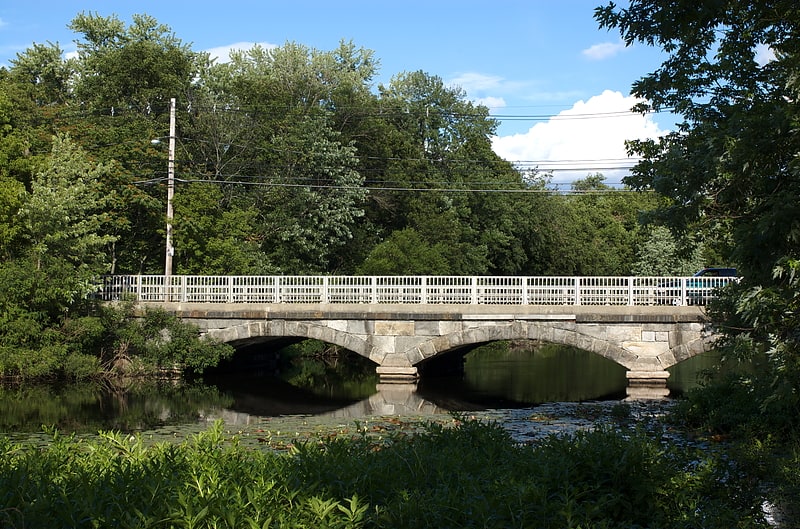
Bridge in Waltham, Massachusetts. The Newton Street Bridge is a historic bridge carrying Newton Street over the Charles River in Waltham, Massachusetts. The stone arch bridge was built in 1877 on the site of Waltham's first bridge, which was built c. 1761–62. It was designed by Hiram Blaisdell, a specialist in the design of masonry bridges. It consists of three elliptical arch segments on granite piers. The arches are formed of granite voussoirs, and the facing of the bridge is predominantly rough rock. It is the only 19th-century bridge in Waltham to escape significant alteration.
The bridge was listed on the National Register of Historic Places in 1989.[8]
Gore Place
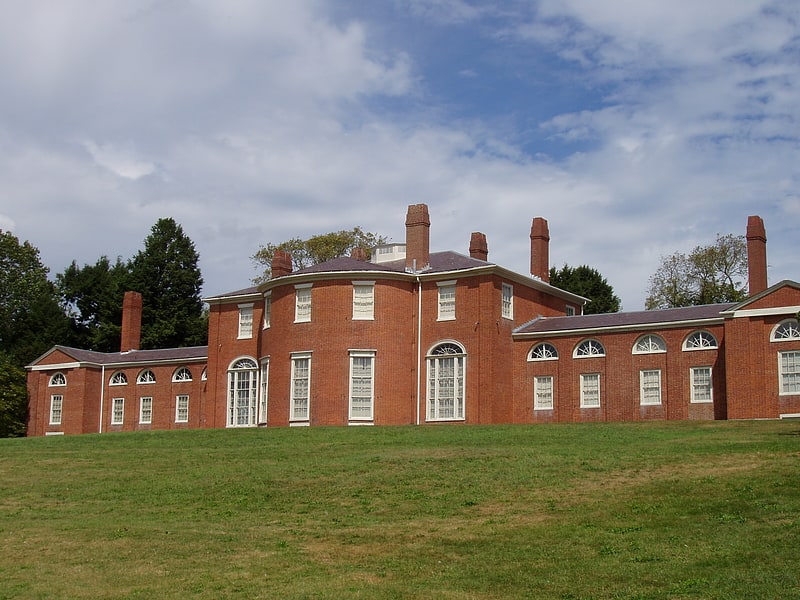
Museum in Waltham, Massachusetts. Gore Place is a historic country house, now a museum, located at 52 Gore Street, Waltham, Massachusetts. It is owned and operated by the nonprofit Gore Place Society. The 45-acre estate is open to the public daily without charge; an admission fee is charged for house tours. A number of special events are held throughout the year including an annual sheepshearing festival and a summer concert series.
The mansion was built in 1806 as a summer home for Massachusetts lawyer and politician Christopher Gore. In this house the Gores entertained various notables including the Marquis de Lafayette, Daniel Webster, and James Monroe. The property was designated a National Historic Landmark in 1970 in recognition of its architectural significance as a large-scale Federal style country house, and for its well-preserved domestic staff quarters, which illustrate the changing role of domestic labor over time.[9]
Address: 52 Gore St, 02453 Waltham (Watertown Town)
New Covenant Church of Cambridge
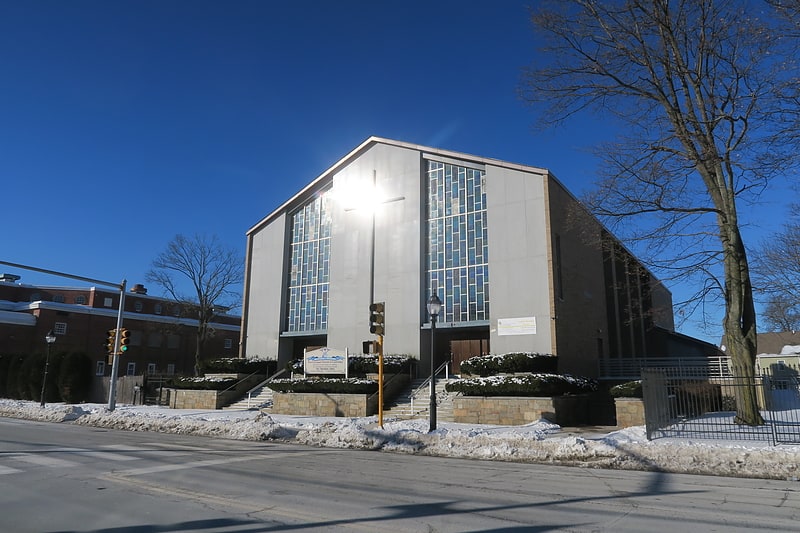
Protestant church in Waltham, Massachusetts. New Covenant Church of Cambridge is located in Waltham, Massachusetts. It is a Haitian church and is headed by the Reverend Esther and the Reverend Thomas St. Louis.[10]
Address: 527 Main St, 02452-5526 Waltham (Waltham)
Lyman Estate

Historical place museum in Waltham, Massachusetts. The Lyman Estate, also known as The Vale, is a historic country house located in Waltham, Massachusetts, United States. It is now owned by the nonprofit Historic New England organization. The grounds are open to the public daily for free; an admission fee is required for the house.
The estate was established in 1793 by Boston merchant Theodore Lyman on 400 acres (160 ha) of grounds, and was the Lyman family's summer residence for over 150 years. It consisted originally of the mansion and its lawns, gardens, greenhouses, woodlands, a deer park, and a working farm. Today the grounds contain a number of specimen trees, a 600-foot (180 m) brick peach wall, and late 19th century rhododendrons and azaleas introduced by the Lyman family.
The fine Federal style mansion, of 24 rooms, was designed by Salem architect Samuel McIntire and completed in 1798. Its grand ballroom, with high ceiling, decorative frieze, large windows, and marble fireplace, was used for formal parties. A smaller oval room was used for family gatherings. McIntire's design was substantially altered during an expansion of the building in 1882 to designs by Richardson, Hartwell and Driver.
The estate's first greenhouse was constructed before 1800 and is thought to be the oldest in the United States. The Grape House, built in 1804 to raise exotic fruits such as oranges, pineapples, and bananas, today houses extensive grape vines, grown from cuttings taken in 1870 from Hampton Court in England. The Camellia House was built around 1820 for cultivation of camellias, introduced to America via Europe in 1797 from coastal China, Japan, and Korea. Many of the Lyman camellias are more than 100 years old. The greenhouses are open to the public.
In the 1960s, the Lyman family, after losing money to a declining textile industry, chose to sell portions of the estate. On October 4, 1962, the property was going to be sold to housing developers, but was instead sold to Bentley University for $365,000. It makes up most of the land that Bentley sits upon.
The estate was designated a National Historic Landmark in 1970 for its architecture and for its landscape design, which is remarkably rare for having retained much of its original 18th-century character.
The estate was one of the filming locations for the 2019 Greta Gerwig film adaptation of Louisa May Alcott's Little Women and the 1979 Merchant Ivory film adaptation of Henry James' novel The Europeans.[11]
Address: 185 Lyman St, 02452 Waltham (Waltham)
Linden Street Bridge
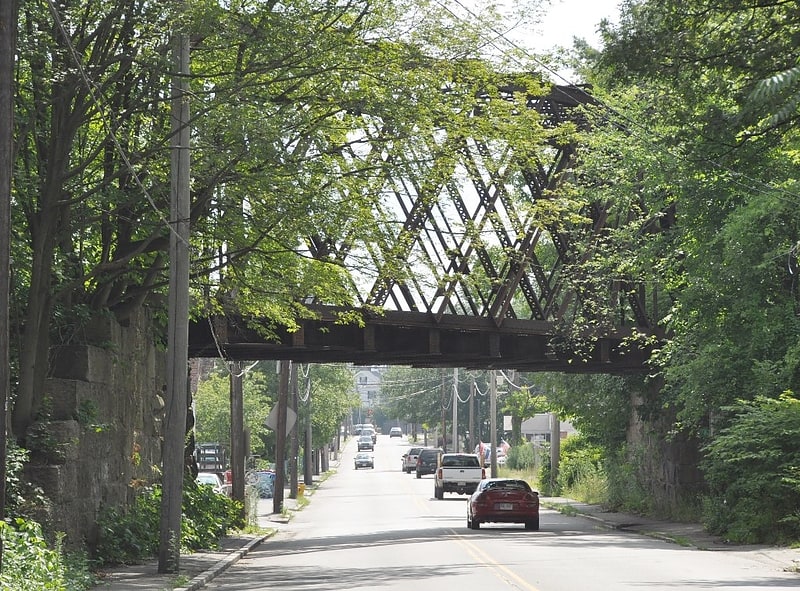
Bridge in Waltham, Massachusetts. The Linden Street Bridge is a historic bridge on the abandoned Central Massachusetts Railroad over Linden Street in Waltham, Massachusetts. It is a riveted lattice through truss bridge, built in 1894 by the Pennsylvania Steel Company, and is one of only three such bridges left in the state. The bridge is 98 feet 3 inches long and 17 feet wide, with an inside truss height of 21 feet 11.5 inches, and rests on granite abutments. The design of the bridge was based on that of the Northampton crossing of the Connecticut River by the same railroad. The line has been out of service since 1975.
The bridge was listed on the National Register of Historic Places in 1989.[12]
Bentley University
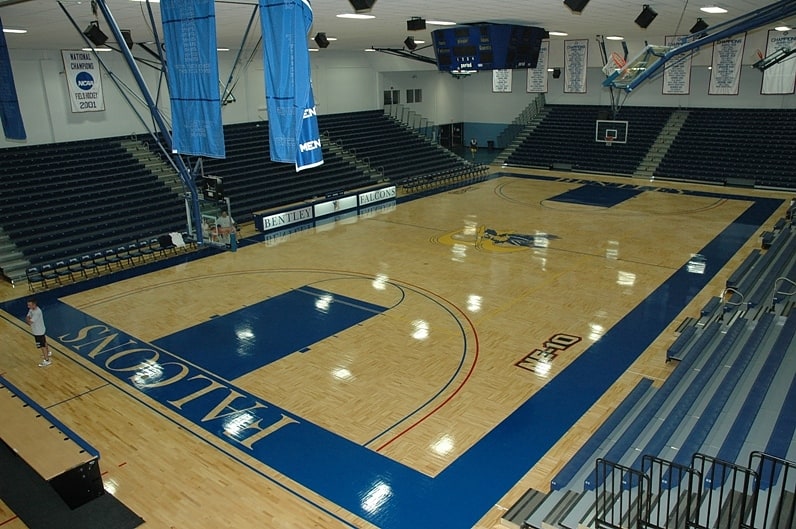
Private university in Waltham, Massachusetts. Bentley University is a private university focused on business and located in Waltham, Massachusetts. Founded in 1917 as a school of accounting and finance in Boston's Back Bay neighborhood, Bentley moved to Waltham in 1968. Bentley awards Bachelor of Science degrees in 14 business fields and Bachelor of Arts degrees in 11 arts and sciences disciplines, offering 36 minors spanning both arts and science and business disciplines. The graduate school emphasizes the impact of technology on business practice, and offers PhD programs in Business and Accountancy, the Bentley MBA with 16 areas of concentration, an integrated MS+MBA, seven Master of Science degrees, several graduate certificate programs and custom executive education programs.
Bentley's athletic teams compete in Division II of the NCAA (except for men's hockey, which competes in Division I) and are known collectively as the Bentley Falcons. They compete in the Northeast-10 Conference.[13]
Address: 175 Forest St, Waltham (Waltham)
Waltham

High school in Waltham, Massachusetts. Waltham High School is a public high school located in Waltham, Massachusetts, United States. It is the only high school operated by Waltham Public Schools.[14]
Address: 16 Felton St, Waltham (Waltham)
Brandeis University
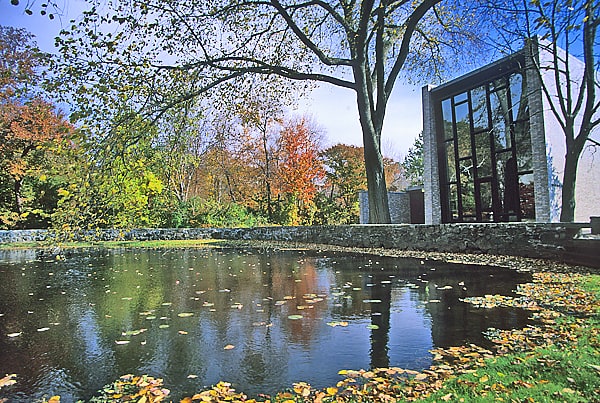
Private university in Waltham, Massachusetts. Brandeis University is a private research university in Waltham, Massachusetts. Founded in 1948 as a non-sectarian, coeducational institution sponsored by the Jewish community, Brandeis was established on the site of the former Middlesex University. The university is named after Louis Brandeis, the first Jewish Justice of the U.S. Supreme Court.
In 2018, it had a total enrollment of 5,800 students on its suburban campus spanning 235 acres (95 hectares). The institution offers more than 43 majors and 46 minors and two-thirds of undergraduate classes have 20 students or fewer. It is classified among "R1: Doctoral Universities – Very high research activity" and is a member of Association of American Universities and the Boston Consortium, which allows students to cross-register to attend courses at other institutions including Boston College, Boston University and Tufts University.
The university has a strong liberal arts focus and attracts a geographically and economically diverse student body, with 72% of its non-international undergraduates being from out of state, 50% of full-time undergraduates receiving need-based financial aid and 13.5% being recipients of the federal Pell Grant. 34% of students identify as Jewish. It has the eighth-largest proportion of international students of any university in the United States. Alumni and affiliates of the university include former first lady of the United States Eleanor Roosevelt, Nobel Prize laureate Roderick MacKinnon and Fields Medalist Edward Witten, as well as foreign heads of state, congressmen, governors, diplomats, and recipients of the Nobel Prize, Pulitzer Prize, Academy Award, Emmy Award, and MacArthur Fellowship. Brandeis University is accredited by the New England Commission of Higher Education.[15]
Address: 415 South St, 02453 Waltham (Waltham)
Trinity Church
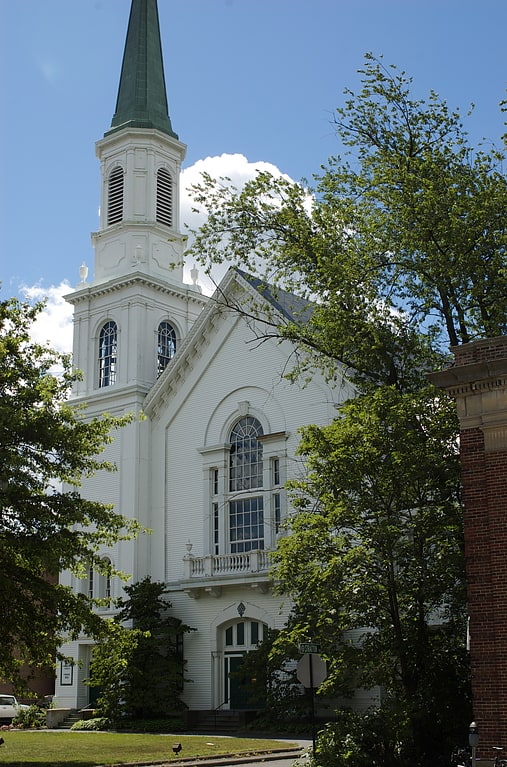
Church in Waltham, Massachusetts. The Trinity Church, formerly the First Congregational Church, is a historic church in Waltham, Massachusetts. The present church building, an architecturally distinctive blend of Romanesque and Georgian Revival styling, was built in 1870 for a congregation established in 1820. It was listed on the National Register of Historic Places in 1989.[16]
St. Mary's Roman Catholic Church Complex
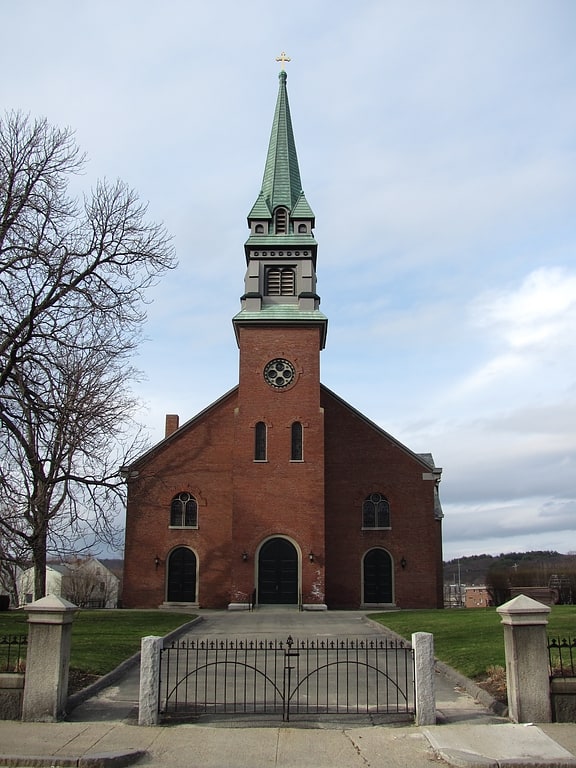
Building in Waltham, Massachusetts. St. Mary's Roman Catholic Church Complex is a historic multi-building church complex at 133 School Street in Waltham, Massachusetts. Established as a parish in 1835, it is the city's oldest Roman Catholic establishment. Its 1858 Romanesque Revival church and 1872 Second Empire rectory are particularly fine architectural examples of their styles. The complex was listed on the National Register of Historic Places in 1989.[17]
Address: 133 School St, 02452 Waltham (Waltham)
Usen Castle
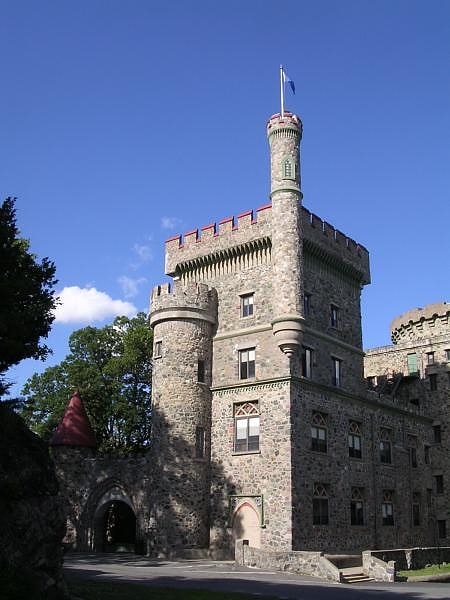
Building in Waltham, Massachusetts. The Castle, also known as Usen Castle, is a historic building at 415 South Street in Waltham, Massachusetts. The Medieval style structure, built in the style of a Norman castle in 1928, stands on the campus of Brandeis University, where it served as a dormitory until 2017. The building, the design of which is unlike any other on the campus or in the city, was listed on the National Register of Historic Places in 1979.[18]
Address: 415 South St, 02453 Waltham (Waltham)
Grove Hill Cemetery
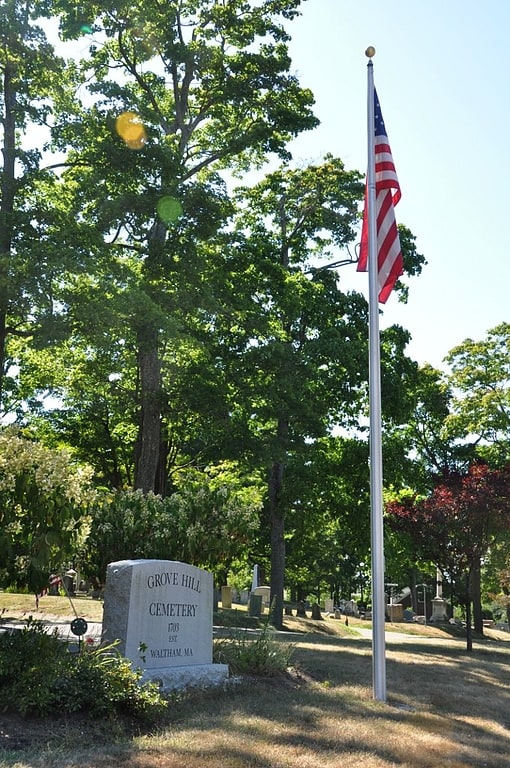
Cemetery in Waltham, Massachusetts. The Grove Hill Cemetery is a historic cemetery at 290 Main Street in Waltham, Massachusetts. Established in 1703, the cemetery was Waltham's only cemetery until 1857, when Mount Feake Cemetery opened. It was authorized in 1703, but its initial 2.3-acre parcel of land was not purchased until 1704. The first documented burial, however, took place in November 1703. The northwest section of the cemetery is its oldest portion, and includes a number of unmarked gravesites. The cemetery continues in active use today, and contains a representative sample of funerary art spanning 300 years. It now covers more than 9 acres, extending between Main and Grove Streets. Its main entrance features posts with an Egyptian Revival theme, a style continued with the presence of obelisks dispersed on the grounds.
The cemetery was listed on the National Register of Historic Places in 1989.[19]
Beth Eden Baptist Church

Church building in Waltham, Massachusetts. The Beth Eden Baptist Church is a historic Baptist church building at 82 Maple Street in Waltham, Massachusetts. Built in 1891, it is a fine local example of Romanesque Revival architecture, and is further notable as the oldest church on Waltham's South Side. The church was added to the National Historic Register of Historic Places in 1989. Its current minister is Rev. Dr. Sylvia Torrence Johnson.[20]
First Parish Church

Unitarian universalist church in Waltham, Massachusetts. The First Parish Church is a historic church at 50 Church Street in Waltham, Massachusetts, whose Unitarian Universalist congregation has a history dating to c. 1696. The current meeting house was built in 1933 after a fire destroyed the previous building on the same site. It is a Classical Revival structure designed by the nationally known Boston firm of Allen & Collens. The church building was listed on the National Register of Historic Places in 1989.[21]
Hager–Mead House

The Hager–Mead House is a historic house at 411 Main Street in Waltham, Massachusetts. The 2+1⁄2-story wood-frame house was built in 1795, and is one of the city's small number of 18th-century houses. It is five bays wide and two deep, with chimneys set in the ridge, and a center entry flanked by Doric pilasters and topped by a six-pane transom window and modillioned cornice. The house was built by Samuel Hager, a farmer from Watertown, who promptly sold it Stephen Mead, a blacksmith, in 1796.
The house was listed on the National Register of Historic Places in 1989.[22]
Central Square Historic District
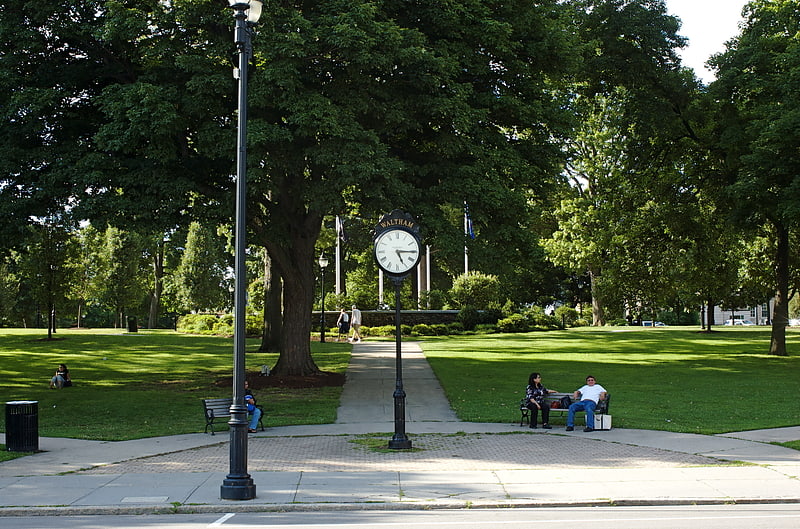
The Central Square Historic District is a historic district encompassing the central town common of the city of Waltham, Massachusetts, and several commercial buildings facing the common or in its immediate vicinity. The common is bounded by Carter, Moody, Main, and Elm Streets; the district includes fourteen buildings, which are located on Main, Elm, Lexington, and Church Streets, on the north and east side of the common. The district was listed on the National Register of Historic Places in 1989.
Although Waltham was settled in the 17th century and incorporated as a town in 1738, it had no recognizable town center until the 1830s, when the nearby Boston Manufacturing Company gave the town the land that now serves as its central square. The area was further enhanced as a central location by the arrival of the railroad, and the construction of the Moody Street bridge across the Charles River, both in the 1840s. Waltham was incorporated as a city in 1884. Its City Hall, a 1924–26 Georgian Revival building designed by William Rogers Greely, stands on the common at the corner of Main and Elm Streets. The oldest municipal building in the district is the 1887 fire station at 25 Lexington Street; it is a brick Queen Anne structure designed by local architect Samuel Patch. It stands next to the 1890 police station building, designed by Hartwell & Richardson. A row of commercial buildings stand across Main Street, facing the common. Many of these were designed by architect Henry W. Hartwell, as was the Music Hall building at 15 Elm Street. Most of these buildings were built between 1880 and 1920.[23]
The Oxford
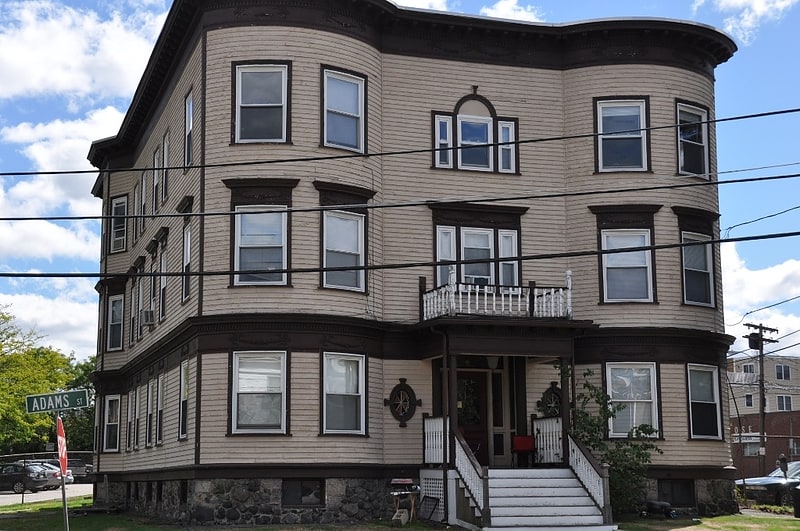
Building in Waltham, Massachusetts. The Oxford is a historic multiunit residential building in Waltham, Massachusetts. The double triple decker apartment house was built in 1897, during the last major phase of development on the city's South Side, and is one of its only surviving houses of that type. It has well-preserved Colonial Revival features, including a dentillated and modillioned cornice. Its front entry is flanked by a pair of bowed window projections, and is sheltered by a portico supported by Tuscan columns.
The building was listed on the National Register of Historic Places in 1989.[24]
Henry N. Fisher House

The Henry N. Fisher House is a historic house at 120 Crescent Street in Waltham, Massachusetts. It is a 2+1⁄2-story wood-frame structure, with the asymmetrical massing typical of Queen Anne houses. It has a wraparound porch with turned posts, lattice railing, and a sunburst motif in the gabled pediment above the steps. The interior has well-preserved woodwork and marble fireplaces. The house was built c. 1881–86, and is a well-preserved Queen Anne Victorian on the city's south side. It was home for many years to Henry N. Fisher, who served as city mayor in the late 1880s, and was a foreman at the Waltham Watch Company.
The house was listed on the National Register of Historic Places in 1989.[25]
O'Hara Waltham Dial factory
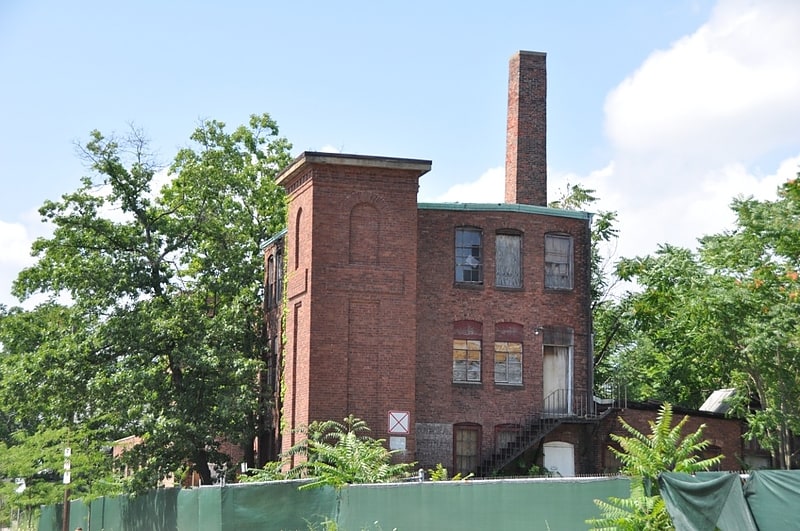
Building in Waltham, Massachusetts. The O'Hara Waltham Dial Company was a historic factory building at 74 Rumford Avenue in Waltham, Massachusetts. The three story brick structure was built in 1897 by Daniel O'Hara, and housed his company, a spinoff from the Waltham Watch Company which specialized in the manufacture of a variety of clock faces. The building had distinctive corner towers with panelled brick surfaces, although these were a later addition. O'Hara's company operated until the late 1950s; the facility was then used in the manufacture of traffic signals and luggage.
The building was listed on the National Register of Historic Places in 1989.
On April 5th, 2019 the city of Waltham issued a Notice of Unsafe Structure for the building. On June 12th, 2019 it was decided that the building is beyond repair and must be demolished. Subsequently, the building was demolished. The lot is currently vacant with some of the original foundations remaining.[26]
Walter E. Fernald Developmental Center
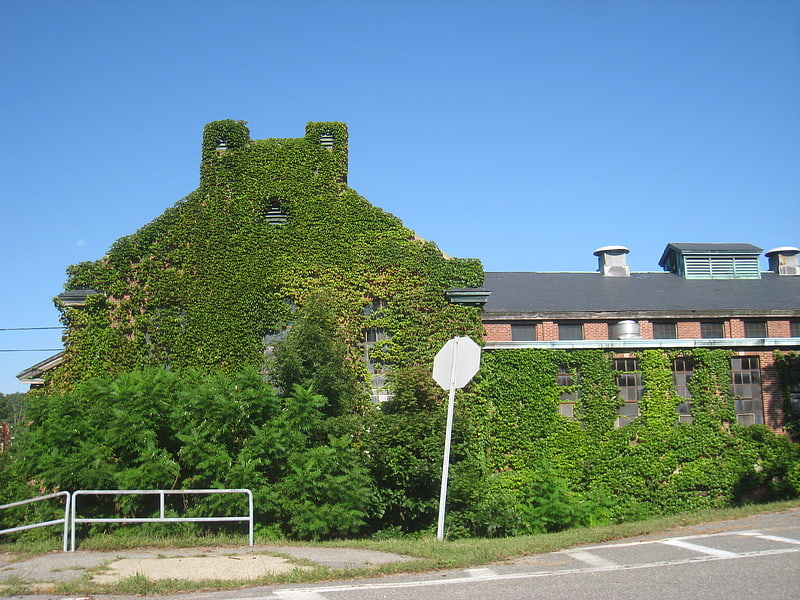
Medical institution in Waltham, Massachusetts. The Walter E. Fernald State School, later the Walter E. Fernald Developmental Center, was the Western hemisphere's oldest publicly funded institution serving people with developmental disabilities. Originally a Victorian sanatorium, it became a "poster child" for the American eugenics movement during the 1920s. It later was the scene of medical experiments in the 20th century. Investigations into this research led to new regulations regarding human research in children.
The school occupies a 186 acres (75 ha) property off Trapelo Road in Waltham, Massachusetts.[27]
Stark Building
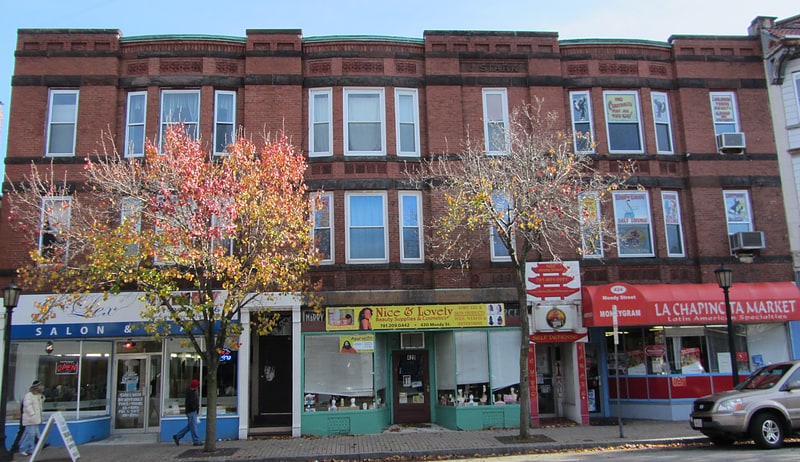
Building in Waltham, Massachusetts. The Stark Building is a historic commercial building in Waltham, Massachusetts. The three story brick building was built in 1891 by John Stark, Jr. the owner of a successful manufacturer of watchmaking tools. It is one of Waltham's few surviving and well-preserved Queen Anne commercial buildings, having only received significant alteration to its storefronts. The building was listed on the National Register of Historic Places in 1989.[28]
Lord's Castle
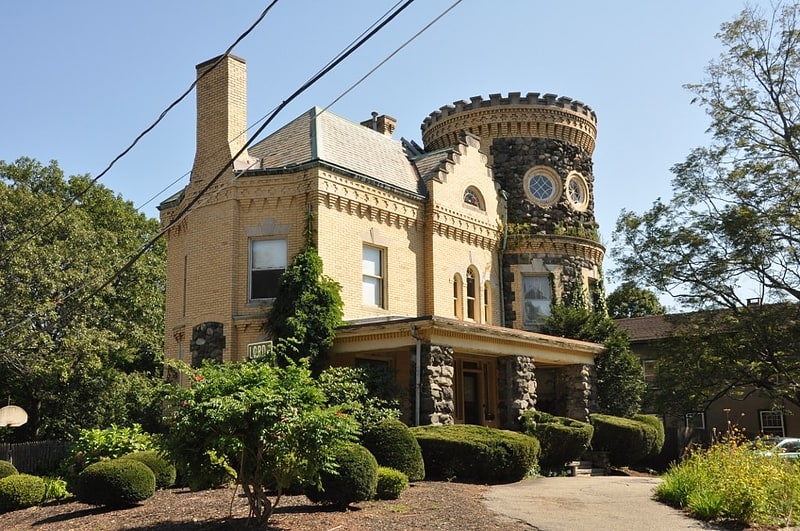
Lord's Castle is a historic house at 211 Hammond Street in Waltham, Massachusetts.
Rufus Lord built the home in 1886 on property purchased from Oel Farnsworth. Lord, who owned a prominent construction business in Waltham, was known for his work on the Company F State Armory at Sharon and Curtis Streets.
The 2+1⁄2-story masonry house was built as a private residence inspired by Norman castles. Its most prominent feature is a large three-story circular tower with extensive corbelling and crenellations, details that are repeated on the main block of the house. It reportedly took Lord ten years to complete.
The house was listed on the National Register of Historic Places in 1989.[29]
Rev. Thomas Hill House
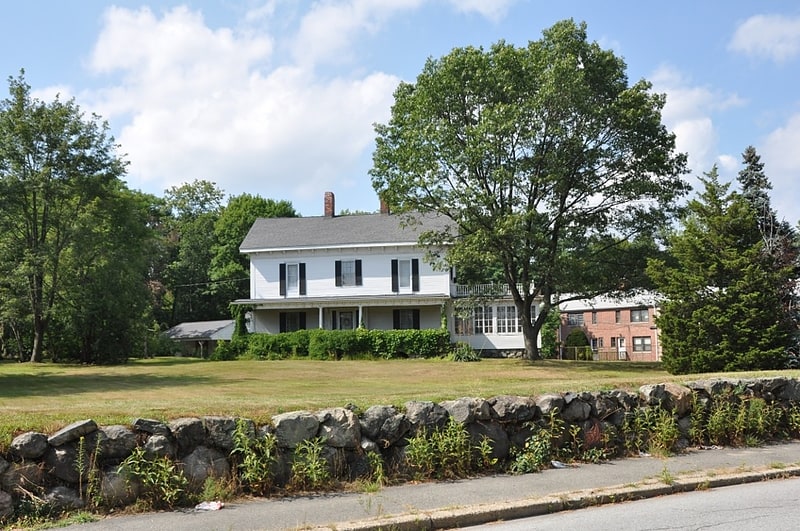
The Rev. Thomas Hill House is a historic house in Waltham, Massachusetts. The 2+1⁄2-story wood-frame house was built in 1845 for the noted clergyman Thomas Hill. He was resident at the house while he served as minister of Waltham's First Parish, and for two other periods before his death in 1891. The house is a transitional Greek Revival-Italianate structure, three bays wide, with a side-gable roof that has bracketed eaves.
The house was listed on the National Register of Historic Places in 1989.[30]
Harrington Block
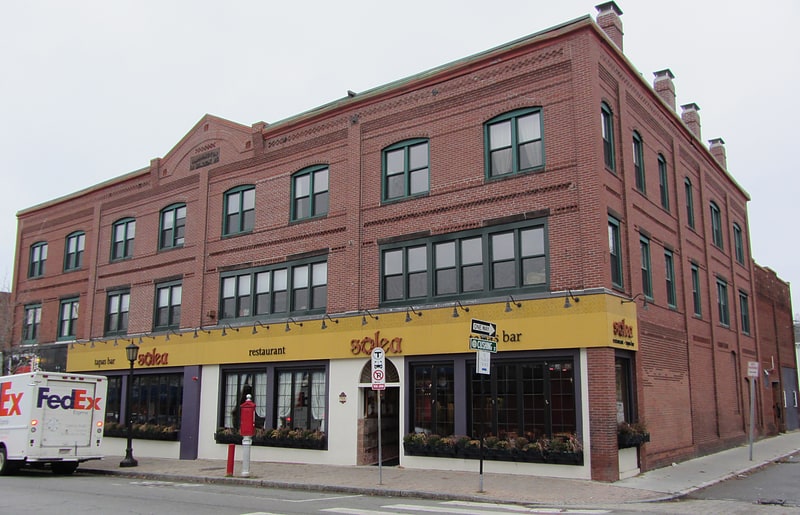
Building in Waltham, Massachusetts. The Harrington Block is a historic commercial and retail building at 376–390 Moody Street in Waltham, Massachusetts. The three story brick building was built 1884-85 by Charles Harrington, a local real estate speculator who was also employed by the Boston Manufacturing Company. It is one of the city's few Queen Anne commercial building, and is the oldest commercial building on Moody Street to escape major alteration. The ground floor originally housed retail establishments, while the upper floors were residential.
The building was listed on the National Register of Historic Places in 1989.[31]
Charles Baker House
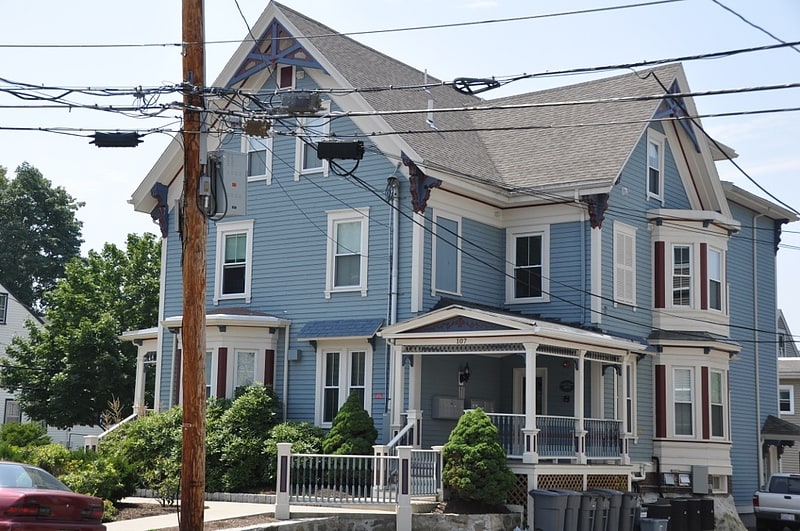
The Charles Baker House is a historic house in Waltham, Massachusetts. Built about 1880, it is one of the city's best examples of Stick style architecture, and a good example of worker housing built for employees of the Waltham Watch Company. It was listed on the National Register of Historic Places in 1989.[32]
Charles Baker Property
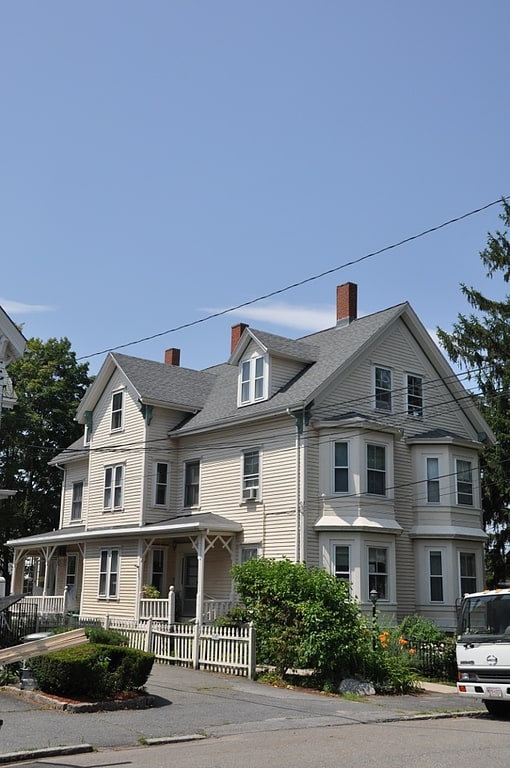
The Charles Baker Property is a historic house in Waltham, Massachusetts. Built about 1882, it is a well-preserved example of a period two-family residence built for workers of the American Watch Company. It was listed on the National Register of Historic Places in 1989.[33]
Newell D. Johnson House
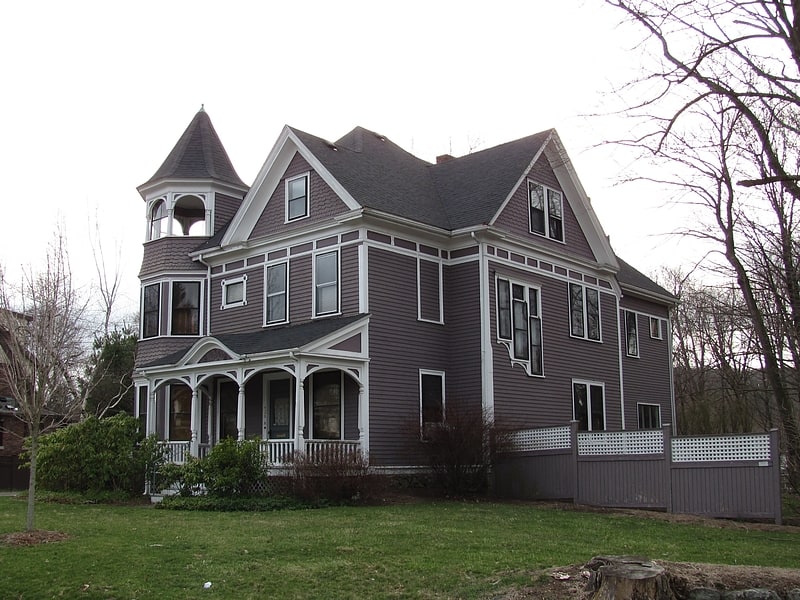
The Newell D. Johnson House is a historic house at 428 Lexington Street in Waltham, Massachusetts. The 2+1⁄2-story wood-frame house was built in 1894, and is one of the most elaborate Queen Anne houses in the city's Piety Corner neighborhood. It has an octagonal tower at one corner with a pyramidal roof, bands of decorative cut wood shingling, and fluted porch posts. Newell Johnson, a dentist, had thi house built on the site of the Sanderson House, one of the first to be built in the area.
The house was listed on the National Register of Historic Places in 1989.[34]
E. Sybbill Banks House
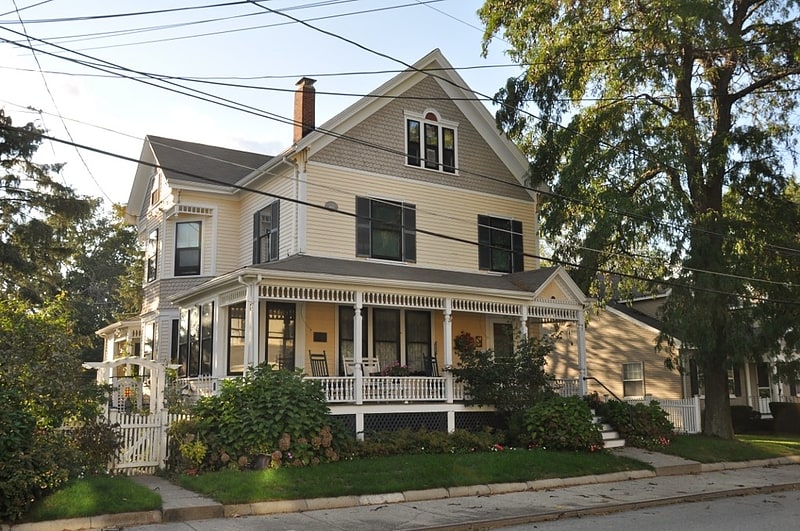
The E. Sybbill Banks House is a historic house at 27 Appleton Street in Waltham, Massachusetts. Built in 1892, it is an excellent local example of vernacular Queen Anne styling. It was built for E. Sybbil Banks, the spinster daughter of Nathaniel Prentice Banks who was also a prominent local civil servant. The house was listed on the National Register of Historic Places in 1989.[35]